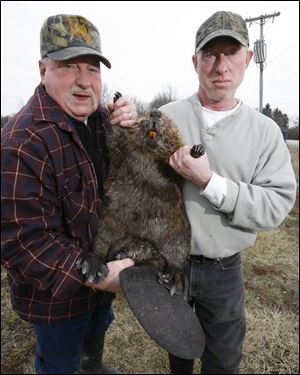
Extra weekend of deer hunting also part of 2006-07 regulations
2/14/2006An extra weekend of gun-deer hunting, set for mid-December, will become part of the 2006-2007 Ohio deer seasons if the Ohio Wildlife Council gives its approval.
The Council last week initially reviewed the plan and the status of the state's post-seasons deer herd but will not make a decision until its April 5 meeting, when it will consider numerous hunting, trapping and commercial fishing proposals.

Merl Downs, left, and Red Sekinger hold the first beaver trapped in recent history at Magee Marsh State Wildlife Area in western Ottawa County. They noted what appeared to be a beaver lodge and secured a permit to trap the animal.
In between will be a round of open-house/public forums, set for March 5 in the five districts' wildlife headquarters, and a statewide public hearing in Columbus on March 9.
The extra gun weekend, which would be open for all legal deer hunting gear, from shotguns and select handguns to archery tackle and muzzleloading rifles, is proposed for Dec. 16-17.
Dave Risley, executive administrator of wildlife management and research for the Ohio Division of Wildlife, said that hunter sentiment has been running two to one in favor of the extra gun hunting since he floated it as an "idea" a month ago.
Overall the additional hunting might increase the all-seasons harvest slightly, but it also could draw some harvest away from the traditional "shotgun week" after Thanksgiving, or even from the muzzleloading or archery seasons. It will take an actual season to see just how much of an impact the extra weekend will make, Risley said.
The primary reasoning behind the proposal is to increase hunting opportunity for hunters who may not be able to take much time off during shotgun week or during the statewide muzzleloader season, which falls between Christmas and New Year's holidays but which does not always include a weekend because it is calendar-dependent.
A recent survey done in conjunction with Ohio State University showed that lack of sufficient time is a major reason why some individuals do not or no longer hunt deer, Risley said. "They wanted more time with the gun."
Risley also is proposing that the Deer Zones remain the same as in 2005 as far as counties included in each, and that each zone keep the same annual deer bag-limit. Zone A, comprised of 20 west and northwest counties, would remain at one deer. Zone B, 30 counties including several in northwest Ohio, would keep a two-deer limit. The 38-county Zone C, primarily southeastern, would retain a three-deer limit.
Shotgun week would run Nov. 27 through Dec. 3 and muzzleloader season would run Dec. 27 through 30 as usual. A map of the proposed zones is available by visiting www.ohiodnr.com/wildlife.
To offset concerns among some upland hunters, Risley is proposing to extend the pheasant hunting season an additional weekend "since we give up one weekend in December for pheasant hunters." He also would extend the archery season three additional days, through Feb. 3 instead of the usual Jan 31, as an offset for bowhunters. Archery season would begin Oct. 7. The statewide youth gun-season would be held Nov. 18-19.
Ohio had a pre-seasons deer herd indexed at 650,000, and the preliminary all-seasons bag was nearly 208,000. As final figures are compiled, however, Risley expects the bag to grow to around 210,000, to finish right in the middle of the pre-seasons forecast of 204,000 to 216,000 deer. The all-seasons bag a year ago was 217,505 from a herd indexed at 700,000.
The bag for the 2005-2006 archery season, now part of the all-seasons total, is set at almost 59,000 deer, just slightly fewer than the record 60,623 in 2004-05 Risley expects this fall's pre-seasons herd to be back in the 650,000 range, or possibly slightly lower. He said that roughly east of a line between Cincinnati and Ashtabula, the deer herd is being reduced in size, largely because habitats are maturing and not capable of supporting as many deer as they once did.
"We saw a blip in the number of spike bucks this year [in the eastern half]. A lot of that is nutrition related."
But by keeping pressure on the herd with liberal harvest strategies, more browse will be available for remaining deer, improving animal quality, Risley explained.
Mature forest simply is not prime deer cover, whereas a patchwork of brushlands, scrublands and young forest is ideal. A mix of woodlots, brushlands and stream bottoms with agricultural land also is ideal, as evidenced by an increase in deer numbers west of the Cincinnati-Ashtabula line.
In regard to deer bag-limits and zones, Risley noted that a one-deer zone-limit usually will allow a herd to grow, a two-deer zone-limit will keep a herd "close to stable," and a three-deer zone-limit is aimed at herd reduction.
The deer manager said that new tools are helping as well.
"We're trying to fine-tune our deer model with this FLIR camera system." FLIR stands for "forward-looking infrared."
A FLIR camera can be mounted on a helicopter as an aid in the post-season deer census.
"It really picks up the deer. A really good census can help us validate or correct our deer models."